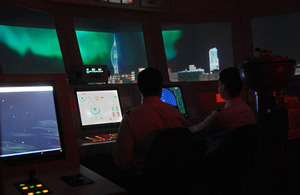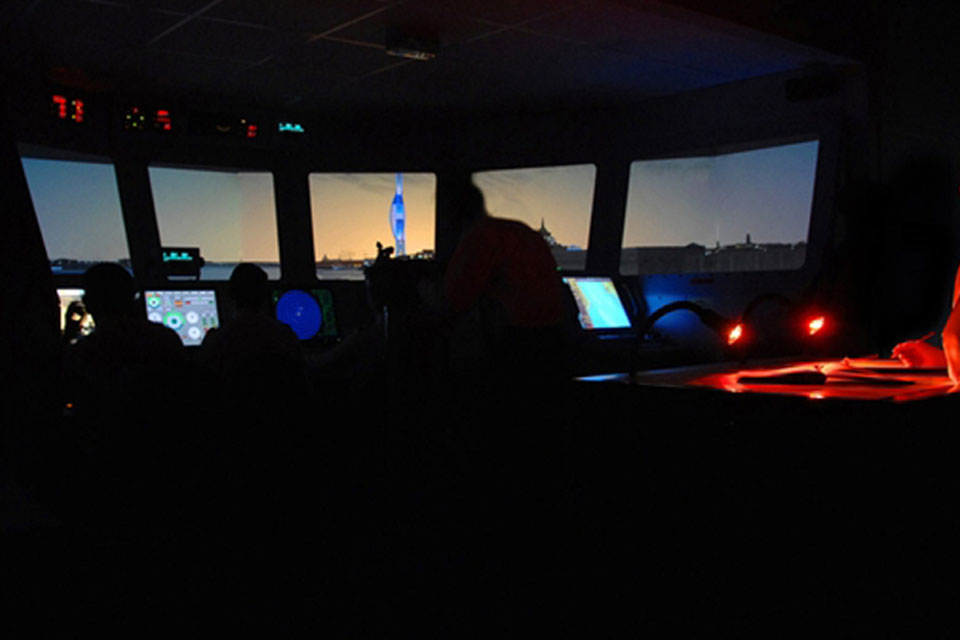Upgraded ship simulator aids Royal Navy training
The most advanced ship simulator in the Navy has been installed at Dartmouth, featuring photo-realistic recreations of key harbours to train bridge teams.

The replica bridge at Britannia Royal Naval College Dartmouth [Picture: Crown Copyright/MOD 2012]
The upgrade to the replica bridge at Britannia Royal Naval College (BRNC) features photo-realistic recreations of key harbours such as Portsmouth and Plymouth, immersing trainee naval officers, budding navigators and experienced ship’s teams in an almost-real world as they hone their ship piloting skills safely on dry land.
There are four bridge simulators to train navigators and bridge teams - two at HMS Collingwood and one each at Dartmouth and Faslane, all of which have been in use for several years.
It’s the photo-realism of the upgrade to the BRNC trainer which takes the training to the next level:
Whereas in the past you’d just see a row of houses, now there are specific buildings,” explains Lieutenant Sam Stephens, head of navigation at Dartmouth.
Buildings such as the distinctive Wilton Hotel on Plymouth’s Grand Parade. It’s painted gold - like the real thing - and you can clearly read the lettering. The same goes for the Spice Island Inn in Portsmouth.
Portsmouth Harbour is the piece de resistance of the upgrade. A graphics specialist from the simulator’s developers Transas spent five days photographing every aspect of the waterfront and environs - by day and by night.
It means that, in the dark, Gunwharf Quays with its myriad bars and restaurants lights up, as does ‘The Lipstick’ building (officially No 1 Gunwharf Quays). The waters reflect this neon world, as well as the yachts in the marina and HMS Warrior.
Such features aren’t just ‘nice to have’, say the Dartmouth staff, but are important in making the training as realistic as possible - which in turn means students get more out of it:
The graphics are fantastic, much more realistic - they really capture you. The realism makes the difference,” says Lieutenant Simon Preece, who is on the BRNC navigational staff.
You’re absorbed by what is going on. You forget that you’re not in Plymouth or Portsmouth.
The simulator - which features the front section of a generic warship’s bridge, plus giant display screens in a 180-degree arc to recreate the outside world - is powered by the equivalent of ten high-spec gaming computers.
The system can also recreate a lookout’s view through binoculars, while the ‘ship handling’ characteristics - length, beam, displacement and the like - perfectly mirror most classes of ships in the fleet (the main exception presently being the new Type 45 destroyers).
As well as locations and harbours, which can be loaded in a matter of seconds (the Portsmouth Harbour file is 630 megabytes - enough data to fill a CD), the computer recreates pretty much all sea and weather conditions one of Her Majesty’s Ships might encounter: driving rain or snow, hurricanes, sandstorms and fogbanks.
That’s not to say that the simulator is perfect, or, ultimately, a substitute for the real thing. It struggles with very heavy seas (winds of Force 10 and above) and especially waves over the bow. Turn it down a few notches to 6 or 7 and the realism returns:
I sat at the back of the room and watched a group of senior officers on a command course swaying around,” says Lieutenant Stephens.
“Some people have even asked if it’s on hydraulics. It’s not. It simply tricks the mind.”

The replica bridge at Britannia Royal Naval College Dartmouth [Picture: Crown Copyright/MOD 2012]
As well as giving cadets their first taste of guiding a ship safely through the Seven Seas, the BRNC simulator is used by bridge teams of Devonport-based ships to practise leaving or entering tricky or unusual harbours, plus ‘rules of the road’ and officer of the watch manoeuvres, while warfare officers undergoing their initial training will spend around 30 hours on the simulator:
You can run through any scenario on here that you wouldn’t want to try for real - it’s a safe environment - as well as everyday manoeuvres, such as replenishing at sea, and navigating in fog or poor weather conditions,” Lieutenant Stephens adds.